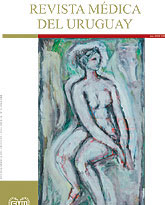CADASIL
Comunicación de una familia uruguaya con definición clínica, imagenológica, anatomopatológica y genética molecular
Palabras clave:
CADASIL, EXONES, RECEPTORES NOTCH, MUTACIÓNResumen
Introducción: el síndrome CADASIL (Cerebral Dominant Arteriopathy with Subcortical Infarcts and Leukoencephlopathy) es una microangiopatía no amiloidea, no ateromatosa que se transmite en forma autosómica dominante y cuyas principales manifestaciones clínicas ocurren a nivel cerebral. Su diagnóstico requiere criterios clínicos, imagenológicos y genéticos moleculares.
Material y método: se estudiaron anatomopatológicamente mediante biopsia de piel y músculo y estudio genético molecular a tres integrantes de una familia con diagnóstico de CADASIL.
Resultados: los exámenes clínicos, paraclínicos, neurológicos y ultraestructural de biopsia de piel mostraron resultados consistentes con CADASIL. La secuenciación de exones 2,3,4,5,8,11,20,23 del gene NOTCH3 detectó una mutación en forma heterocigota en el exón 5 no descripta en la literatura.
Conclusiones: destacamos la importancia del diagnóstico precoz de esta enfermedad y la definición molecular que permite el asesoramiento genético a todos los integrantes de la familia y, eventualmente, el diagnóstico prenatal.
Citas
(2) Sonninen V, Savontaus ML. Hereditary multi-infarct dementia. Eur Neurol 1987; 27(4): 209-15.
(3) Verin M, Rolland Y, Landgraf F, Chabriat H, Bompais B, Michel A, et al. New phenotype of the cerebral autosomal dominant arteriopathy mapped to chromosome 19: migraine as the prominent clinical feature. J Neurol Neurosurg Psychiatry 1995; 59(6): 579-85.
(4) Glusker P, Horoupian DS, Lane B. Familial arteriopathic leukoencephalopathy: imaging and neuropathologic findings. AJNR Am J Neuroradiol 1998; 19(3): 469-75.
(5) Kalimo H, Viitanen M, Amberla K, Juvonen V, Marttila R, Pöyhönen M, et al. CADASIL: hereditary disease of arteries causing brain infarcts and dementia. Neuropathol Appl Neurobiol 1999; 25(4): 257-65.
(6) Joutel A, Corpechot C, Ducros A, Vahedi K, Chabriat H, Mouton P, et al. Notch3 mutations in CADASIL, a hereditary adult-onset condition causing stroke and dementia. Nature 1996; 383(6602): 707-10.
(7) Tournier-Lasserve E, Joutel A, Melki J, Weissenbach J, Lathrop GM, Chabriat H, et al. Cerebral autosomal dominant arteriopathy with subcortical infarcts and leukoencephalopathy maps to chromosome 19q12. Nat Genet 1993; 3(3): 256-9.
(8) Ruchoux MM, Guerouaou D, Vandenhaute B, Pruvo JP, Vermersch P, Leys D. Systemic vascular smooth muscle cell impairment in cerebral autosomal dominant arteriopathy with subcortical infarcts and leukoencephalopathy. Acta Neuropathol 1995; 89(6): 500-12.
(9) Markus HS, Martin RJ, Simpson MA, Dong YB, Ali N, Crosby AH, et al. Diagnostic strategis in CADASIL. Neurology 2002; 59(8): 1134-8.
(10) Ruchoux MM, Chabriat H, Bousser MG, Baudrimont M, Tournier-Lasserve E. Presence of ultraestructural arterial lesions in muscle and skin vessels of patients with CADASIL. Stroke 1994; 25(11): 2291-2.
(11) Iglesias M, Jimeno M, García M, Mon D, Roquer J, Alameda F, et al. CADASIL electron-dense deposits are not osmiophilic. Report of a non-familial case. ULTRAPATH, 12. Conference on Diagnostic Electron Microscopy with Surgical, Clinical, and Molecular Pathology Correlations Barcelona, Spain July 11-16, 2004.
(12) Joutel A, Favrole P, Labauge P, Chabriat H, Lescoat C, Andreux F, et al. Skin biopsy immunostaining with a Notch3 monoclonal antibody for CADASIL diagnosis. Lancet 2001; 358(9298): 2049-51.
(13) Ishida C, Sakajiri K, Yoshita M, Joutel A, Cave-Riant F, Yamada M. CADASIL with a novel mutation in exon 7 of NOTCH3 (C388Y). Intern Med 2006; 45(16): 981-5.
(14) Bancroft J, Stevens A. Theory and practice of histological techniques. 2 ed. New York: Churchill Livingstone, 1982.
(15) Joutel A, Vahedi K, Corpechot C, Troesch A, Chabriat H, Vayssière C, et al. Strong clustering and stereotyped nature of Notch3 mutations in CADASIL patients. Lancet 1997; 350(9090): 1511-5.
(16) Bousser M, Tournier-Lasserve E. Cerebral autosomal dominant arteriopathy with subcortical infarcts and leukoence-phalopathy: from stroke to vessel wall physiology. J Neurol Neurosurg Psychiatry 2001; 70(3): 285-7.
(17) Yanagawa S, Ito N, Arima K, Ikeda S. Cerebral autosomal recessive arteriopathy with subcortical infarcts and leukoencephalopathy. Neurology 2002; 58(5): 817-20.
(18) Peters N, Opherk C, Bergmann T, Castro M, Herzog J, Dichgans M. Spectrum of mutations in biopsy-proven CADASIL: implications for diagnostic strategies. Arch Neurol 2005; 62(7): 1091-4.
(19) Joutel A, Monet M, Domenga V, Riant F, Tournier-Lasserve E. Pathogenic mutations associated with cerebral autosomal dominant arteriopathy with subcortical infarcts and leukoencephalopathy differently affect jaggedl binding and Notch3 activity via the RBP/JK signalling pathway. Am J Hum Genet 2004; 74(2): 338-47.
(20) Vikelis M, Papatriantafyllou J, Karageorgiou CE. A novel CADASIL causing mutation in a stroke patient. Swiss Med Wkly 2007, 137(21-22): 323-5.












